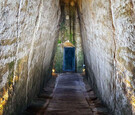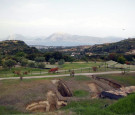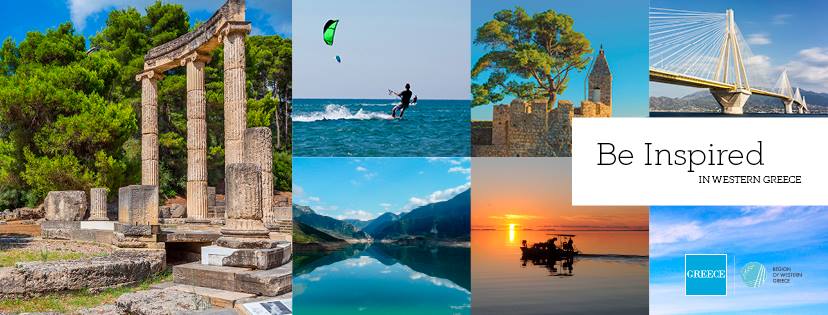Συνέδριο Επιχειρηματικότητας
Αξιοθέατα
Δυτική Ελλάδα.
Μια εμπνευσμένη επιλογή.
Μια αρχαία γη ευλογημένη με σύγχρονα ιδεώδη που παραμένει αληθινή στον εαυτό της και στους επισκέπτες της.
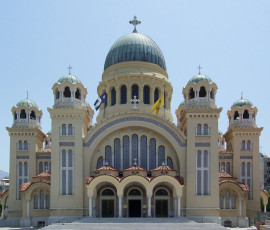
Άγιος Ανδρέας Πάτρας: Ο Πολιούχος της Πάτρας, σύμβουλο της Ορθοδοξίας
Ο νέος μεγαλοπρεπέστατος Βυζαντινού ρυθμού ναός θεμελιώθηκε το 1908 από τον Γεώργιο τον Α΄, και εγκαινιάσθηκε το 1974 από τον Μητροπολίτη Πατρών κ. Νικόδημο. Είναι ο μεγαλύτερος και λαμπρότερος ναός των Βαλκανίων και ένας από τους μεγαλύτερους της Ευρώπης. Την επίβλεψη των εργασιών ανέγερσης είχε ο αρχιτέκτονας Αναστάσιος Μεταξάς και μετά το θάνατό του (1937) ο αρχιτέκτονας Γεώργιος Νομικός.
Ο κεντρικός τρούλος του Ναού έχει ύψος 46 μέτρα, πάνω του στηρίζονται ένας πεντάμετρος επίχρυσος σταυρός και δώδεκα μικρότεροι που συμβολίζουν το Χριστό και τους δώδεκα μαθητές του. Στο χώρο του Ναού μπορούν να εκκλησιαστούν τουλάχιστον 5.000 άτομα.
Δίπλα στον παλιό Ναό είναι το πηγάδι του Αγίου Ανδρέα. Στη θέση του προϋπήρχε η πηγή της Δήμητρας στην οποία λειτουργούσε και μαντείο μόνο για αρρώστους. Η περιοχή της μαντικής πηγής ήταν ο τόπος όπου δίδασκε ο Απόστολος Ανδρέας. Σύμφωνα με την παράδοση δίπλα σ' αυτή την πηγή σταυρώθηκε.
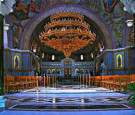
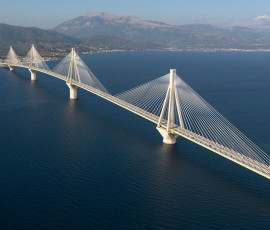
Γέφυρα Ρίου – Αντιρρίου: Η μεγαλύτερη καλωδιωτή γέφυρα της Ευρώπης
Η γέφυρα Ρίου-Αντιρρίου «Χαρίλαος Τρικούπης» βρίσκεται στη διασταύρωση δύο μεγάλων οδικών δικτύων. Του άξονα Αθηνών – Κορίνθου – Πατρών – Καλαμάτας («Ολυμπία Οδός») και του άξονα Αντιρρίου – Ιωαννίνων («Ιονία Οδός») οι οποίοι συνδέουν σημαντικές Ελληνικές πόλεις και αποτελούν μέρους του Ευρωπαϊκού οδικού δικτύου.
Η γέφυρα Ρίου – Αντιρρίου είναι η μεγαλύτερη καλωδιωτή γέφυρα της Ευρώπης με μήκος 2253 μέτρα, ενώ καινοτόμες μελέτες και μέθοδοι υπεράκτιας κατασκευής χρησιμοποιήθηκαν, ώστε να γίνει πραγματικότητα αυτή η μοναδική καλωδιωτή γέφυρα πολλαπλών ανοιγμάτων.
Σας συστήνουμε ανεπιφύλακτα να περπατήσετε τη γέφυρα αφού υπάρχει ειδική ζώνη για τους πεζούς. Πιο συγκεκριμένα η Γέφυρα διαθέτει προστατευμένα πεζοδρόμια τόσο στην ανατολική όσο και στη δυτική πλευρά της. Πρόσβαση στα πεζοδρόμια αυτά έχετε μέσω των κλιμακοστασίων που υπάρχουν στην πλευρά του Ρίου και του Αντιρρίου ή από τους χώρους στάθμευσης κοντά στον σταθμό διοδίων.
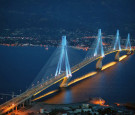
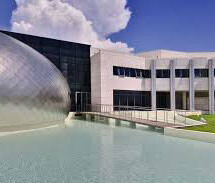
Αρχαιολογικό μουσείο Πάτρας: Η ιστορία της Πάτρας μέσα σε ένα εντυπωσιακής αρχιτεκτονικής μουσείο
Το νέο αρχαιολογικό μουσείο Πάτρας, βρίσκεται στη βόρεια είσοδο της πόλης. Καλύπτει συνολική επιφάνεια 5955 τ.μ., και περιλαμβάνει τρεις μεγάλες αίθουσες για την μόνιμη έκθεση, μια αίθουσα που φιλοξενεί περιοδικές εκθέσεις, μοντέρνα αίθουσα υποδοχής, καφετέρια, ελεύθερο περιβάλλοντα χώρο.
Τα εκθέματα του μουσείου που αφορούν τη χρονική περίοδο μεταξύ 3000 π.Χ. και 4ου αιώνα μ.Χ., προέρχονται από την πόλη της Πάτρας, καθώς επίσης και από τις περιοχές της νότιας και δυτικής Αχαΐας.
Η έκθεση χωρίζεται σε τρεις μεγάλες θεματικές ενότητες. Την ιδιωτική ζωή, την δημόσια ζωή και τα νεκροταφεία αντίστοιχα. Τα πιο περίφημα από όλα τα αρχαία εκθέματα μεταξύ των άλλων, είναι αυτά που συναντώνται την Μυκηναϊκή και την Ρωμαϊκή περίοδο, κατά την διάρκεια των οποίων η Πάτρα βρισκόταν στο απόγειό της. Η Πάτρα ιδρύθηκε ως αποικία από τον Οκταβιανό Αύγουστο το 14 π.Χ. κα έπαιξε σημαντικό ρόλο στην ιστορία της ρωμαϊκής αυτοκρατορίας, φτάνοντας στο απόγειο του πλούτου της τον 20 αιώνα μ.Χ.
Ωράριο λειτουργίας:
- Δευτέρα κλειστό
- (Μέχρι 1η Απριλίου) Καθημερινά: 8:00 – 15:00
- (Από 1η Απριλίου) Καθημερινά: 8:00 – 20:00
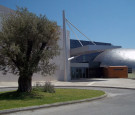
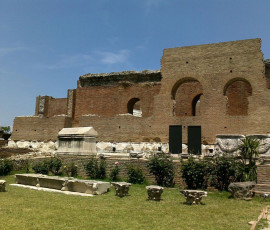
Αρχαίο Ωδείο Πάτρας – Ένα αρχιτεκτονικό κομψοτέχνημα στην «Άνω Πόλη»
Στα δυτικά της Ακρόπολης, στην Άνω Πόλη, βρίσκεται το Ρωμαϊκό Ωδείο της Πάτρας που ανεγέρθηκε νωρίτερα από το Ωδείο της Αθήνας (Ηρώδειο 160 μ.Χ.). Ο Παυσανίας που επισκέφτηκε την Πάτρα περί το 170 μ.Χ. γράφει «έχει την ωραιότερη διακόσμηση που έχω δει, αν εξαιρέσει βέβαια κανείς αυτή του Ωδείου της Αθήνας». Όπως αναφέρει ο Παυσανίας, μέσα στο Ωδείο, που ήταν συνεχόμενο της αρχαίας Αγοράς, υπήρχε άγαλμα του Απόλλωνα, που έγινε από λάφυρα του πολέμου, κατά των Γαλατών (279 π.Χ.) όταν οι Πατρινοί είχαν βοηθήσει τους Αιτωλούς.
Στους αιώνες που ακολούθησαν, οι σεισμοί, οι πόλεμοι και οι κατακτητές κατέστρεψαν το Ωδείο και το κάλυψαν με άλλα κτίρια και χώματα. Από το μικρό λόφο που δημιουργήθηκε, έμεναν ακάλυπτα μόνο ελάχιστα τμήματα. Ξαναήρθε στο φως το 1889, όταν έγιναν εργασίες εκσκαφής στο λόφο για την επιχωμάτωση του λιμανιού.
Πέρασαν αρκετές δεκαετίες έως ότου ξεκινήσει η διαδικασία της αναστήλωσής του που ολοκληρώθηκε το 1956, χρονιά κατά την οποία το Αρχαίο Ωδείο απέκτησε την αρχική του μορφή. Την ίδια δεκαετία, μετατράπηκε ο περιβάλλον χώρος σε αρχαιολογικό με την έκθεση σε αυτόν, σαρκοφάγων, ψηφιδωτών και άλλων αρχαίων ευρημάτων.
Το Ωδείο έχει όλα τα βασικά μέρη του θεάτρου, κοίλο, ορχήστρα, προσκήνιο, σκηνή, παρασκήνια και στις 23 σειρές καθισμάτων του, δύναται να φιλοξενηθούν 2.300 θεατές.
Από τη θέσπιση του Διεθνούς Φεστιβάλ Πάτρας, το Αρχαίο Ωδείο αποτελεί τη βασική του έδρα, φιλοξενώντας τους καλοκαιρινούς μήνες κορυφαία ελληνικά και ξένα καλλιτεχνικά συγκροτήματα.
Ωράριο λειτουργίας: 8:00 – 14:30 (εκτός Δευτέρας)
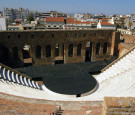
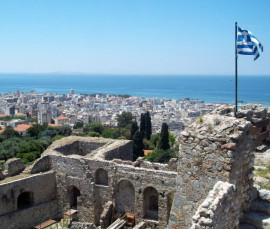
Το Κάστρο της Πάτρας: Ένα μνημείο με ενδιαφέρουσα ιστορία και εξαιρετική θέα της πόλης
Το Κάστρο της Πάτρας χτίστηκε κατά το β’ μισό του 6ου μ.Χ. αιώνα, επάνω στα ερείπια της αρχαίας Ακρόπολης. Βρίσκεται σ’ ένα χαμηλό λόφο του Παναχαϊκού Όρους σε απόσταση 800 μέτρων περίπου από την ακτή. Τα τείχη του περικλείουν μια έκταση 22.725 τ.μ. και αποτελείται από έναν τριγωνικό εξωτερικό περίβολο, ενισχυμένο με πύργους και προμαχώνες, που προστατεύονταν αρχικά από βαθιά τάφρο και ένα εσωτερικό περίβολο που υψώνεται στη Β.Α. γωνία και επίσης περιβάλλεται από τάφρο.
Κατασκευάστηκε από τον Ιουστινιανό μετά το καταστροφικό σεισμό του 551, με υλικά προχριστιανικών οικοδομημάτων, για την άμυνα της περιοχής και των κατοίκων της. Στους αιώνες που ακολούθησαν και ως το Β’ Παγκόσμιο Πόλεμο, παρέμεινε σε αδιάκοπη χρήση για την άμυνα της πόλης, αλλά και ως διοικητικό και στρατιωτικό κέντρο.
Στους Βυζαντινούς αιώνες, μέχρι τον ερχομό των Φράγκων (1205) το πολιόρκησαν Σλάβοι, Σαρακηνοί, Βούλγαροι, Νορμανδοί κ.α. χωρίς όμως να μπορέσουν να το κατακτήσουν. Στα 805 μ.Χ. οι κάτοικοι της πόλης πολιορκήθηκαν στο κάστρο από Σλάβους και Σαρακηνούς και η νίκη τους που αποδόθηκε σε θαύμα του πολιούχου Αγίου Ανδρέα, ήταν σημαντική για την αναχαίτιση των βαρβαρικών επιδρομών στη Πελοπόννησο.
Οι Φράγκοι σταυροφόροι, το μεγάλωσαν, το ενίσχυσαν και άνοιξαν τάφρο στις τρείς πλευρές του. Το 1278 υποθηκεύτηκε στο Λατίνο Αρχιεπίσκοπο, ενώ το 1408 παραχωρήθηκε από τον Πάπα για πέντε χρόνια και έναντι μισθώματος, στους Ενετούς. Στα χέρια του Λατίνου Αρχιεπισκόπου έμεινε ως το 1430, όπου απελευθερώθηκε από τον Κωνσταντίνο Παλαιολόγο. Ο Κωνσταντίνος προχώρησε σε προσθήκες και επισκευές των τειχών.
Σκλαβώθηκε στα χρόνια της τουρκοκρατίας και πέρασε στα χέρια των Ελλήνων το 1828 μετά την απελευθέρωσή του από τον Γάλλο στρατηγό Μαιζόν.
Κατά τα χρόνια 1941 -1944, ήταν στη γερμανική κατοχή από την οποία απελευθερώθηκε μαζί με την Πάτρα στις 4 Οκτωβρίου 1944. Από το 1973 το Κάστρο είναι στην εποπτεία της 6ης Εφορείας Βυζαντινών Αρχαιοτήτων. Στο λυόμενο θεατράκι (640 θέσεων) που βρίσκεται στον εσωτερικό περίβολο, φιλοξενούνται κάθε καλοκαίρι πολιτιστικές εκδηλώσεις.
Οι οικοδομικές φάσεις που διακρίνονται σήμερα στο κάστρο αποτελούν μαρτυρία των εργασιών που πραγματοποιήθηκαν από τους εκάστοτε κατακτητές του για την επισκευή του και την προσαρμογή του στις εξελίξεις της πολεμικής τεχνολογίας.
Σε ειδική εσοχή στην τοιχοποιία, είναι εντοιχισμένος κορμός αγάλματος και κεφάλι ανδρός των ρωμαϊκών χρόνων. Το παραμορφωμένο αυτό άγαλμα πήρε μυθικές διαστάσεις στα μάτια των κατοίκων της Πάτρας. Έγινε το στοιχειό της πόλης, η «Πατρινέλα». Η παράδοση λέει ότι ήταν γυναίκα μεταμορφωμένη σε άνδρα στα χρόνια της Τουρκοκρατίας που φυλάει την πόλη από επιδημίες και κλαίει τις νύχτες, όταν πεθαίνει κάποιος γνωστός Πατρινός.
Ωράριο λειτουργίας: Καθημερινά 8:00 – 15:00 (εκτός Δευτέρας)
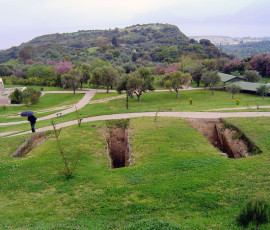
Μυκηναϊκό Νεκροταφείο Βούντενης
Ο μυκηναϊκός οικισμός της Βούντενης αποτελεί μία από τις σημαντικότερες εγκαταστάσεις της λεγόμενης περιφέρειας του Μυκηναϊκού κόσμου. Όπως αποδείχτηκε από τις ανασκαφικές έρευνες που έγιναν τόσο στον οικισμό όσο και στο νεκροταφείο, η ζωή του οικισμού διήρκεσε σχεδόν πεντακόσια χρόνια (1500-1000 π.Χ.). Η Βούντενη και ειδικότερα το πλάτωμα Μπόρτζι είχε όλες τις προϋποθέσεις που ήταν αναγκαίες όχι μόνο για την ίδρυση, αλλά και για την επιβίωση - για μεγάλο χρονικό διάστημα - μιας μυκηναϊκής εγκατάστασης.
Ο οικισμός στη θέση Μπόρτζι αποτελούσε τον κεντρικό πυρήνα και σε περίπτωση κινδύνου «καταφύγιο», μιας πλειάδας άλλων μικρότερων συνοικισμών που ήταν αναπτυγμένοι στα πεδινά τμήματα της ευρύτερης περιοχής. Οικοδομικά στοιχεία αυτών των συνοικισμών έχουν αποκαλυφθεί σε διάφορα σημεία κατά την διάρκεια σωστικών ανασκαφών. Αν και η έρευνα δεν έχει ακόμη ολοκληρωθεί, εκτός των μυκηναϊκών οικοδομικών καταλοίπων, έχουν αποκαλυφθεί και ορισμένα που χρονολογούνται από την αρχαϊκή έως την κλασική περίοδο.
Η μυκηναϊκή εγκατάσταση της Βούντενης, είχε πρόσβαση σε πλούσιες πεδινές και ορεινές περιοχές, ικανές να προσφέρουν αυτάρκεια προϊόντων για τη διαβίωση των κατοίκων της. Μεγάλες και εύφορες καλλιεργήσιμες εκτάσεις υπήρχαν στα πεδινά και παράκτια τμήματα, ενώ τα πρανή του Παναχαϊκού όρους προσφέρονταν για την ανάπτυξη της κτηνοτροφίας, του κυνηγιού καθώς και τον προσπορισμό άφθονης δομικής και ναυπηγικής ξυλείας από τα δάση της περιοχής.
Νοτιοανατολικά του οικισμού, στο χώρο εκείνο που σήμερα είναι γνωστός με τα τοπωνύμια Αγραπιδιά και Αμυγδαλιά, βρίσκεται το νεκροταφείο του μυκηναϊκού οικισμού που καταλαμβάνει έκταση περίπου 30 στρεμμάτων και είναι οργανωμένο σε επάλληλα άνδηρα ύψους 2-4μ, τα δε όριά του συμπίπτουν με εκείνα του μαλακού μαργαρικού πετρώματος που ήταν απαραίτητο για τη διάνοιξη των θαλαμοτών τάφων.
Ωράριο Λειτουργίας: 8:00 - 15:00
